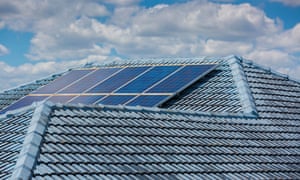Extract from The Guardian
RepuTex modelling suggests surge in state schemes and rooftop solar
will reduce wholesale prices, making gas- and coal-fired power less
competitive
Australia is on track to achieve 50% renewable electricity by 2030
even without new federal energy policies, according to modelling by the
energy analysts RepuTex.
The analysis, to be released on Wednesday, suggests that a surge in renewable energy driven by state schemes and rooftop solar installations will reduce wholesale prices from $85 per MWh to $70 over the next three years.
Lower prices will make gas- and coal-fired power less competitive, even without a market mechanism to make fossil fuels reflect the cost of pollution or a direct constraint on emissions, although a lack of federal policy could lead to longer-term price rises, RepuTex found.
During the election campaign, the Coalition attacked Labor for its
50% renewable energy target – as well as its 45% emissions reduction
target – claiming they would harm energy-intensive industries and cost jobs.The analysis, to be released on Wednesday, suggests that a surge in renewable energy driven by state schemes and rooftop solar installations will reduce wholesale prices from $85 per MWh to $70 over the next three years.
Lower prices will make gas- and coal-fired power less competitive, even without a market mechanism to make fossil fuels reflect the cost of pollution or a direct constraint on emissions, although a lack of federal policy could lead to longer-term price rises, RepuTex found.
But after the Coalition won on 18 May, the Liberal senator Arthur Sinodinos urged the government to use the changing energy mix to bolster its environmental credentials, and treasurer Josh Frydenberg declared that the “inevitable” transition to low-emissions sources created an opportunity for the country.
With the federal renewable energy target set to expire in 2020, RepuTex noted that state policy was now the dominant signal for new investment in the national energy market.
RepuTex projected that current policies, including renewable energy targets in Queensland and Victoria, were likely to drive about 13GW of new renewable energy capacity by 2030, in addition to 6GW of renewable capacity currently committed for development.
The head of research at RepuTex, Bret Harper, said the 6GW of renewable capacity to be installed by the end of 2020 “should begin to reduce the role of marginal gas-fired generation in the market, leading to lower wholesale prices”.
"Without a plan to prepare for the exit of fossil fuel generation we forecast a return to a boom-bust investment cycle"
“The competitive pressure of new low-cost supply is modelled to significantly limit demand for coal-fired energy, even without a direct emission constraint,” he said.
“As a result, fossil fuel generation is modelled to be more broadly on the decline, displaced by a large volume of solar, wind and pumped hydro.”
RepuTex noted that the absence of a federal energy policy framework could force wholesale prices back up to $100 per MWh in the long term as ageing coal-fired generators are forced to close, reducing supply.
“The low price environment over the medium term is good for consumers, but not so good for inflexible generators, which will be at risk of being pushed out of the market by cheaper, more flexible technologies like wind and solar with pumped hydro,” Harper said.
“Without a plan to prepare for the exit of fossil fuel generation we forecast a return to a boom-bust investment cycle, with elevated wholesale prices and increased volatility, rather than a more orderly transition.”
The Coalition’s strong results in Queensland have emboldened conservatives who before the election demanded Scott Morrison examine whether a new coal-fired plant was needed in north Queensland and sign off on a shortlist for the electricity underwriting scheme that includes “one very small” coal project in New South Wales proposed by the coal baron and LNP donor Trevor St Baker.
The Coalition began 2019 by trying to bolster its climate credentials with a $2bn cash injection to the emissions reduction fund and government support for the “battery of the nation” project in Tasmania.
But a feasibility study for the Tasmanian interconnector proposal states the benefits are greater “when approximately 7,000MW of the national electricity market’s present coal-fired generation capacity retires”.

No comments:
Post a Comment